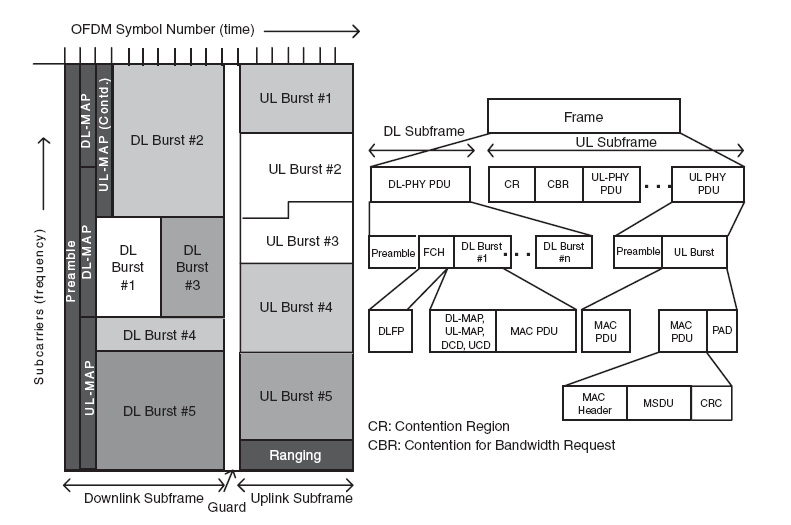
The WiMAX physical layer is based on orthogonal frequency division multiplexing. OFDM is the transmission scheme of choice to enable high-speed data, video, and multimedia communications and is used by a variety of commercial broadband systems, including DSL, Wi-Fi, Digital Video Broadcast-Handheld (DVB-H), and MediaFLO, besides WiMAX. OFDM is an elegant and efficient scheme for high data rate transmission in a non-line-of-sight or multipath radio environment.
The WiMAX PHY layer is also responsible for slot allocation and framing over the air. The minimum time-frequency resource that can be allocated by a WiMAX system to a given link is called a slot. Each slot consists of one subchannel over one, two, or three OFDM symbols, depending on the particular subchannelization scheme used. A contiguous series of slots assigned to a given user is called that user's data region; scheduling algorithms could allocate data regions to different users, based on demand, QoS requirements, and channel conditions.
Figure 2 shows an OFDMA and OFDM frame when operating in TDD mode. The frame is divided into two subframes: a downlink frame followed by an uplink frame after a small guard interval. The downlink-to-uplink-subframe ratio may be varied from 3:1 to 1:1 to support different traffic profiles. WiMAX also supports frequency division duplexing, in which case the frame structure is the same except that both downlink and uplink are transmitted simultaneously over different carriers. Some of the current fixed WiMAX systems use FDD. Most WiMAX deployments, however, are likely to be in TDD mode because of its advantages. TDD allows for a more flexible sharing of bandwidth between uplink and downlink, does not require paired spectrum, has a reciprocal channel that can be exploited for spatial processing, and has a simpler transceiver design. The downside of TDD is the need for synchronization across multiple base stations to ensure interference-free coexistence. Paired band regulations, however, may force some operators to deploy WiMAX in FDD mode.
As shown in Figure 2, the downlink subframe begins with a downlink preamble that is used for physical-layer procedures, such as time and frequency synchronization and initial channel estimation. The downlink preamble is followed by a frame control header (FCH), which provides frame configuration information, such as the MAP message length, the modulation and coding scheme, and the usable subcarriers. Multiple users are allocated data regions within the frame, and these allocations are specified in the uplink and downlink MAP messages (DL-MAP and UL-MAP) that are broadcast following the FCH in the downlink subframe. MAP messages include the burst profile for each user, which defines the modulation and coding scheme used in that link. Since MAP contains critical information that needs to reach all users, it is often sent over a very reliable link, such as BPSK with rate 1/2 coding and repetition coding. Although the MAP messages are an elegant way for the base station to inform the various users of its allocations and burst profiles on a per-frame basis, it could form a significant overhead, particularly when there are a large number of users with small packets (e.g., VoIP) for which allocations need to be specified. To mitigate the overhead concern, mobile WiMAX systems can optionally use multiple sub-MAP messages where the dedicated control messages to different users are transmitted at higher rates, based on their individual SINR conditions. The broadcast MAP messages may also optionally be compressed for additional efficiency.

Figure 2. A sample TDD frame structure for mobile WiMAX
WiMAX is quite flexible in terms of how multiple users and packets are multiplexed on a single frame. A single downlink frame may contain multiple bursts of varying size and type carrying data for several users. The frame size is also variable on a frame-by-frame basis from 2 ms to 20 ms, and each burst can contain multiple concatenated fixed-size or variable-size packets or fragments of packets received from the higher layers. At least initially, however, all WiMAX equipment will support only 5 ms frames.
The uplink subframe is made up of several uplink bursts from different users. A portion of the uplink subframe is set aside for contention-based access that is used for a variety of purposes. This subframe is used mainly as a ranging channel to perform closed-loop frequency, time, and power adjustments during network entry as well as periodically afterward. The ranging channel may also be used by subscriber stations or mobile stations (SS/MS) to make uplink bandwidth requests. In addition, best-effort data may be sent on this contention-based channel, particularly when the amount of data to send is too small to justify requesting a dedicated channel. Besides the ranging channel and traffic bursts, the uplink subframe has a channel-quality indicator channel (CQICH) for the SS to feed back channel-quality information that can be used by the base station (BS) scheduler and an acknowledgment (ACK) channel for the subscriber station to feed back downlink acknowledgements.
To handle time variations, WiMAX optionally supports repeating preambles more frequently. In the uplink, short preambles, called midambles, may be used after 8, 16, or 32 symbols; in the downlink, a short preamble can be inserted at the beginning of each burst. It is estimated that having a midamble every 10 symbols allows mobility up to 150 kmph.